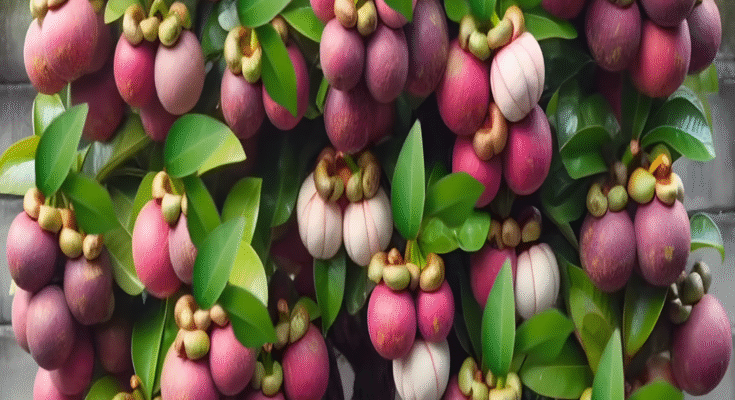New Planting Techniques to Harvest More Mangosteen
Mangosteen, often called the “queen of fruits,” is highly prized for its sweet, juicy white pulp and subtle flavor. While this tropical fruit is cherished across Southeast Asia and gaining popularity worldwide, it is also well known for being a slow grower that demands patience and careful tending. Traditionally, mangosteen trees can take anywhere from 7 to 10 years to bear fruit, and even then, yields can be unpredictable. However, with modern agricultural techniques and improved planting practices, farmers are now finding ways to boost both the quantity and quality of their mangosteen harvests. Let’s explore some of these new techniques that can help you grow mangosteen trees more successfully and enjoy bigger harvests.
1. Selecting Superior Planting Material
The first step toward increasing mangosteen yields is choosing the right planting material. Traditionally, mangosteen is propagated by seeds, which often results in trees with varying quality and longer maturity times. Modern growers now prefer to use vegetative propagation techniques, such as air layering or grafting, to produce saplings that retain the mother tree’s desirable traits. By selecting high-yielding, disease-resistant mother trees for propagation, farmers can ensure that each new tree has the genetic potential for abundant fruit production.
2. Preparing the Soil Properly
Mangosteen trees thrive in deep, well-drained, slightly acidic soil rich in organic matter. New techniques focus on enhancing soil fertility before planting. Many farmers now use green manure and compost to enrich the soil naturally. Adding organic material like coconut husks, composted cow manure, or decomposed leaves improves soil structure, promotes healthy root growth, and increases moisture retention. Some growers even introduce beneficial microbes or mycorrhizal fungi to the soil to improve nutrient absorption.
3. Using Raised Beds for Better Drainage
One common reason mangosteen trees fail is waterlogging. Mangosteen roots are sensitive to excessive water and poor drainage. To counter this, modern growers often plant mangosteen trees on raised beds or mounds about 50–100 cm high. This simple practice ensures that excess rainwater drains away quickly, preventing root rot and other fungal diseases. This technique is especially helpful in regions with heavy rainfall.
4. Mulching and Weed Control
Mulching is another essential technique for boosting mangosteen productivity. A thick layer of organic mulch—such as rice straw, coconut husk, or dried leaves—helps retain soil moisture, suppress weeds, and maintain a cool root environment. It also slowly decomposes, adding nutrients back to the soil. Many farmers now combine mulching with manual weeding to reduce competition for nutrients, giving young mangosteen trees a better chance to thrive.
5. Optimal Plant Spacing
New planting guidelines recommend careful spacing to maximize sunlight and airflow around each tree. Traditionally, mangosteen trees were planted close together, which often led to poor airflow, increased humidity, and a higher risk of fungal diseases. Today, experts suggest planting trees 10–12 meters apart. This wider spacing allows for healthier tree growth, better canopy development, and easier maintenance and harvesting.
6. Smart Irrigation Techniques
Although mangosteen needs a lot of water to produce juicy fruit, water must be supplied correctly. Drip irrigation systems have become increasingly popular among modern mangosteen growers. This method delivers water directly to the root zone, minimizing waste and keeping the soil evenly moist without waterlogging. Using drip irrigation also makes it easier to apply liquid fertilizers and bio-nutrients directly to the roots, boosting growth.
7. Balanced Fertilization
Applying balanced fertilizers at the right stages of growth is crucial. Many growers now use a combination of organic and inorganic fertilizers. During the early growth stage, nitrogen-rich fertilizers help the young trees develop strong foliage. As the trees mature, phosphorus and potassium fertilizers are added to support flowering and fruiting. Additionally, foliar sprays with micronutrients like magnesium and boron help improve fruit set and quality.
8. Pruning for Health and Productivity
Pruning mangosteen trees is a newer practice that helps improve air circulation and light penetration within the canopy. Regularly removing dead, diseased, or overcrowded branches reduces the risk of pest infestations and encourages the tree to focus energy on healthy fruit production. Light pruning also makes it easier to harvest the fruits when they are ready.
9. Pest and Disease Management
Integrated pest management (IPM) has become an important part of modern mangosteen cultivation. Rather than relying solely on chemical pesticides, growers now combine biological control, cultural practices, and selective pesticide use. For example, introducing natural predators like ladybugs can help control pests like aphids, while regular monitoring allows early detection of diseases such as fruit rot or stem canker.
10. Intercropping for Extra Benefits
Some innovative farmers use intercropping to make better use of space while mangosteen trees are still young. Planting fast-growing crops like bananas, pineapples, or legumes between young mangosteen trees provides shade, suppresses weeds, and adds organic matter to the soil when these intercrops are mulched or plowed back. This practice also provides farmers with an extra source of income while waiting for the mangosteen trees to mature.
A Rewarding Future
Adopting these new planting techniques requires extra effort and knowledge, but the rewards are well worth it. By combining better propagation methods, soil improvement, smart irrigation, proper fertilization, and sustainable pest management, today’s growers are proving that mangosteen can be grown more efficiently and harvested in greater numbers than ever before. With patience, care, and innovation, you too can enjoy the sweet success of harvesting more mangosteen for your family or for the market, sharing the “queen of fruits” with the world.



